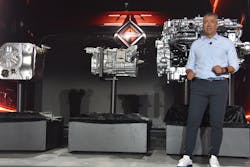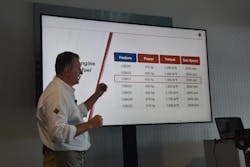Closer look: Navistar’s new powertrain advances emission control
Navistar’s new International S13 Integrated Powertrain, designed in close collaboration with the Traton Group for the North American market, is the last internal combustion engine powertrain the company will develop from a blank slate, and Navistar President and CEO Mathias Carlbaum says they “kept the best for last.”
The 13-liter International S13 engine boasts the combined competency of more than 300 years of combustion engine expertise, he pointed out, and represents the company’s greatest endeavor in more than 15 years, with “hundreds of millions of dollars” poured into its “clean-sheet” creation. And the 14-speed International T14 fully automated manual transmission is Navistar’s first transmission fully designed in-house.
Together, they deliver increased operating efficiency, reliability, and durability, while enhancing performance and reducing operating costs, Navistar executives and subject-matter experts said during a special event Aug. 16 unveiling the new powertrain.
See also: Navistar's new truck includes OEM's final internal combustion engine
But the key to the entire concept is the big metal box connected to the diesel engine.
Difficulties with heavy-duty emission-control systems are one of the biggest pain points in trucking today, leading to revenue-depleting downtime, and huge headaches for fleet managers left to deal with issues like clogged diesel particular filters (DPFs), exhaust gas recirculation (EGR) failures, sensor malfunctions, and more.
Navistar maintains its reimagined dual-stage aftertreatment system, devised concurrently with a selective catalytic reduction (SCR)-based engine, solves those problems through reduced complexity and increased serviceability—allowing the engine to “do what it does best” while saving on-highway fleets time and money.
“If you have the right conditions for your catalysts, with the right temperature and amount of DEF (diesel exhaust fluid) dosed in, they take away all the NOx for you,” said Björn Westman, senior advisor to the Traton Group. “And if you know you have that, you can develop the most efficient engine in front of that aftertreatment.”
‘Lego-style’ design
Michael Grahe, Navistar’s head of operations, said Traton’s modular approach to powertrain construction via standardized interfaces allowed them to achieve a high degree of customization with fewer parts. A “Lego-style” system also allows engineers to focus on refining each specific component, boosting compatibility and performance.
“This new way of designing increases speed to market, improves overall product quality and produces optimum reliability,” Grahe said. “Sounds very logical, right? Yet, as always, the devil lies in the details. Luckily at Navistar, we can use the know-how of our sister brand Scania, which has applied these principals for decades—and Scania was a very good teacher.”
This “holistic” integration also unlocked “significant improvements in fuel efficiency up to 15% (compared to the first International A26 engine spec’d with the 12-speed Eaton Endurant HD automated transmission), considerable reductions in CO2 emissions, and an incremental (52-lb.) weight reduction of the entire system,” Grahe asserted. That 15% fuel-efficiency upgrade—for fleets running the S13 powertrain at its most efficient rating, in combination with the updated International LT aerodynamics package—conserves up to 1,540 gallons of diesel fuel per year. At $4 a gallon, that equals $6,160 in annual savings.
Compelling real-world benefits are the product of a cohesive system “designed from the outset to outperform the competition,” providing customers the tools they need to run their businesses reliably and efficiently today, while they await the zero-emission future promised by the battery-electric vehicles of tomorrow.
“We’ve designed the S13 Integrated Powertrain to ensure it’s as sustainable as possible without compromising anything on performance,” Carlbaum said. “This powertrain marks the greatest leap toward carbon-neutral transport ever made by our company—and I’m certain it is the most efficient powertrain we’ve ever developed.”
Superior emission control
Grahe acknowledged to FleetOwner he’s all too familiar with fleets’ frustrations regarding emission-control system functionality, so he knew full well how important it was for Navistar to get this one right. That’s why the S13’s emission controls were developed as one cohesive system across the engine and aftertreatment.
“Uptime, reliability, and serviceability—these are key things,” Grahe said.
Integrated improvements that enhance overall performance of the aftertreatment system include removal of the EGR cooler and variable-geometry turbocharger (VGT) from the engine, and two stages of DEF dosing, one in the evaporator tube after exhaust flows through turbocharger, and a second in the aftertreatment device.
The EGR cooler in a typical engine helps control NOx emissions. But they routinely fail, creating problems for fleets. The S13 engine still has an EGR, but it’s primarily used for assisting cold starts, not controlling emissions. Removing the cooler eliminates a major hassle—and the possibility of a $2,400 repair bill—and allows the 13-liter engine to generate 15-liter power. “A traditional EGR engine is recirculating about 20% of the gas out of the exhaust flow and into the front of the engine, so … only 80% of your energy is going to the turbo charger,” said David Hillman, general manager for vocational products at Navistar. “With the S13, 100% of the energy is hitting the turbo charger. That allows us to solve a second pain point for customers—and that’s eliminating the variable-geometry turbo.” Instead of a VGT, which is a $4,000 part, the S13 uses a simpler, more reliable, more cost-effective fixed-geometry turbocharger.
Because the S13 is not recirculating inert exhaust gas, more fuel is “clean-burned” during the combustion cycle, reducing the amount of particulate matter, or soot, sent to the aftertreatment, where it accumulates in the DPF. With less soot, and a system that operates at a lower temperature than in a typical EGR engine, a diesel oxidation catalyst and active regeneration are unnecessary. “There’s no fuel dosing anywhere in this device,” Hillman said. Instead, passive regeneration cleans out the DPF in most conditions.
However, NOx emissions and soot are “on a seesaw,” Hillman explained, so as soot goes down, NOx goes up. That’s where the aftertreatment’s maximized SCR performance comes into play, breaking down NOx with dual DEF injections. The result is a system with a stress-free service interval—up to 650,000 miles. “Fleets that keep their trucks five or fewer years will never have to service the aftertreatment device,” Hillman predicted. And if service is required, it’s easily rendered via a removeable plate on the back of the box.
A 13-liter future
Navistar sees the 13-liter engine as the key supplier of internal combustion-engine propulsion for commercial vehicles in the coming decades, even in North America—once the “emotional attachment” to much thirstier 15-liter engines is alleviated, Grahe told FleetOwner. The S13 offers “the best weight-to-component ratio” even in heavy-haul transport, where “every pound counts,” he contended. “We strongly believe, with the performance levels that we’re able to reach, we can cover most applications with a 13-liter engine.”
The S13 delivers up to 515 horsepower and 1,850 lb.-ft. of torque governed at 2,000 revolutions per minute (RPM) across seven engine rating options. The most efficient rating, code 12BGT, is achieved at 400 hp and 1,850 lb.-ft. of torque, Hillman said. The S13 boasts a 23:1 compression ratio, up from 20.5:1 in the current A26 offering, and the fuel pump operates at a 28% lower pressure (1,800 bars). “We don’t need the same amount of internal pressure because of the combustion strategy, and by lowering the pressure in the high-pressure fuel pump, we take less energy to pressurize the fuel, and put it into driving the wheels,” Hillman said.
The engine’s compacted graphite iron block, now with fewer subcomponents, contributes to weight savings, and the standard cast aluminum cam cover and oil pan protect the engine from corrosive road chemicals. A compression release brake with 469 hp of breaking power, also comes standard.
“The S13 operates on low revolution and high torque, which equates to fewer fuel injections, lower parasitic losses, and consequently less fuel consumption,” Grahe said.
Precision power transmission
The T14 transmission was conceived as a “fully automated mechanical gearbox” with an electronic clutch actuator (ECA) integrated with the engine’s software controls. “Gear shifting is perfectly matched to engine revolutions,” Grahe said. “The T14 showcases smooth and quiet operations with "shift-on-the-fly" capabilities in numerous applications and combinations drivers will certainly enjoy.” It’s also “a direct drive in an overdrive package,” he said. The 14th gear is overdrive, the 13th is direct drive, and there are no lockouts, but direct drive delivers “the most efficient transmission of power from the engine to the drive wheels,” Hillman added.
Electronic actuation ensures the clutch won’t lock up, Hillman said, and the lubricated internal components of the T14 ECA aren’t exposed to chassis-air moisture, improving reliability. An air-actuated planetary gear and five bevel gears support compact design, faster reverse speeds, and improved “heavy-load stability and low-speed maneuvering,” Navistar said. Full torque is available at 900 RPM for drivability, and drivers also have access to Economy, Performance, and Performance+ modes, along with “intelligent shifting capabilities,” like skip shifting and turning radius offsets. “We’re able to give drivers the benefit of a quicker-accelerating package in a downsped configuration owners are going to love because it helps save fuel,” Hillman said.
Also standardized for the T14 are an integrated air cooler, chassis coolant-to-transmission oil heat exchanger, and variable oil-volume system for lubricating gears that reduces parasitic losses. And for the first time, International will offer transmissions to U.S. and Canadian fleets with OEM-installed single and dual PTOs.
The International S13 Integrated Powertrain—set to enter production in July 2023, at Navistar’s Huntsville, Alabama, plant—is backed by a five-year warranty; and supported by over-the-air calibration changes and software updates, Navistar’s International 360 service communications tool, and a dealership network with more than 1,000 locations offering ASE-certified technicians in North America. “To ensure superior performance and reliability of the S13 Integrated Powertrain, it’s been designed to meet the toughest requirements of the North American market,” Grahe said. “Before this integrated powertrain goes into serial production, it will have logged more than 4 million miles of field testing on North American roads.
“We are testing on all terrains—from the desert of Arizona to the frozen tundra of Alaska.”
About the Author

Jason McDaniel
Jason McDaniel, based in the Houston TX area, has nearly 20 years of experience as a journalist. He spent 15 writing and editing for daily newspapers, including the Houston Chronicle, and began covering the commercial vehicle industry in 2018. He was named editor of Bulk Transporter and Refrigerated Transporter magazines in July 2020.




